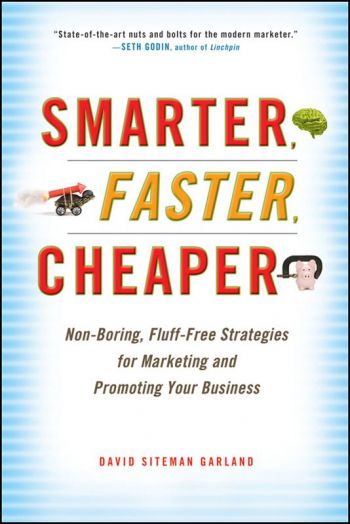Is the Web small banks leg up?
Book Review: Social media and financial literacy efforts could boost your bank
- |
- Written by Jane Haskin
- |
- Comments: DISQUS_COMMENTS
 Smarter, Faster, Cheaper: Non-Boring, Fluff-Free Strategies for Marketing and Promoting Your Business, by David Siteman Garland, Wiley, 230 pp., 2010
Smarter, Faster, Cheaper: Non-Boring, Fluff-Free Strategies for Marketing and Promoting Your Business, by David Siteman Garland, Wiley, 230 pp., 2010
Are you still considering if your bank should become involved in social media through the internet? In his book Smarter, Faster, Cheaper, David Garland answers that question with a resounding “YES,” and he adds that NOW is the time. Although his book isn’t written directly to banks, his ideas can be used by any business to make it more competitive and smarter, with smaller marketing budgets.
Even if you don’t feel social media is right for your bank, you need to read this book to understand how young entrepreneurs think and how marketing is being revolutionized by the internet.
David Garland is a young entrepreneur who founded The Rise To The Top, which he professes to be the #1 non-boring resource for building your business smarter, faster, cheaper. He writes and hosts RISE, a Web show for entrepreneurs and forward thinkers. His costs to produce his Web show are nominal, yet he has a tremendous following of people who consider him to be an expert in developing a new business. Garland emphasizes over and over the need to first provide value to people and then they will want to do business with you.
Over the last 15 years, banking products have continued to become much more complicated. What better way to provide value to your customers and potential customers than by providing educational information to empower them with knowledge about how financial products work and show them how they will benefit?
How can your bank utilize the internet to provide this information? Almost every bank has a website. Use your website as a portal to provide webcast, articles, or audio recordings that allow consumers and businesses to realize you are an expert at banking and you want to provide information that will be helpful to them in reaching their financial goals.
Who in the bank should offer the advice as the expert banker?
Garland suggests it should come from the top. The goal is to become recognized as the most knowledgeable expert when it comes to financial services. In his book, he shows you how to use the internet to drill down and reach individual customers or targeted groups.
How many 20-somethings do you have coming into your bank to transact their banking business? If your bank is like mine, probably not many—even though we are directly across the street from a university and many of the students do bank with us.
Garland provides ideas on how to reach those customers and have a personal relationship with them through the internet. The great news is if you can reach these young customers, make a connection, and provide good value to them, they won’t feel the need to move their accounts when they relocate; as long as they have an internet connection and a debit card, they can conduct their banking.
Another useful resource provided by the book is guidance on monitoring the social media channels to see what is being said about your bank. Garland provides several websites to use that will inform you if your bank’s name is mentioned on the Internet. These comments could be both positive and negative, but you will then have an opportunity to respond to both.
The importance of such alert services can’t be over-stressed.
Before the Internet, what happened when a customers were upset with your bank? They might write a letter to the editor of the local newspaper, plus tell all of their friends and family. This would occur over a period of time. Although you never want your reputation damaged by negative comments from customers, such damage was usually limited to the customer’s circle of friends and family, or in worst cases, the community.
Now, if you have a disgruntled customer, they can walk out of your bank, create a tweet about their complaint, and within minutes inform the entire internet community.
As bankers, we need to look at new ways to market our products and be smarter, faster, and cheaper than the competition. This book will definitely give you new ideas. The internet isn’t going away and we all need to work with the regulators to establish guidelines as to how we as banking experts can utilize this tool to educate and inform the public about financial services.
After reading the book, I would challenge bankers to step outside of the traditional banking model and explore to see if there are ways you can reach your customers that are smarter, faster, and cheaper.
If you'd like to review books for our online book column, or have recently read a book that you found helpful that we haven't already reviewed, please e-mail [email protected]
Want more banking news and analysis?
Get banking news, insights and solutions delivered to your inbox each week.
Tagged under Books for Bankers,














